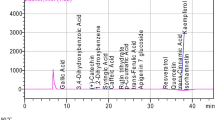Abstract
Annona squamosa and Catunaregam nilotica seeds and oils were characterized for their approximate analysis and physico-chemical properties. The oil and protein contents were 26.8, 17.5 and 40.0, 22.2%, in A. squamosa and C. nilotica seeds, respectively. The oils were extracted using cold extraction (CE) and Soxhlet extraction (SE) methods. Fatty acids and tocopherols were determined by GC–MS and HPLC, respectively. Generally the physico-chemical properties and fatty acids were not significantly (P ≤ 0.05) affected by the extraction methods. The major fatty acids of A. squamosa oil extracted by CE and SE were oleic 49.2 and 50.5%, linoleic 22.3 and 22.7%, palmitic 15.6 and 15.2%, and stearic 10.6 and 9.3%, respectively. While the major fatty acids in C. nilotica oil extracted by CE and SE were oleic 10.5, and 10.4%, linoleic 63.1 and 63.4%, palmitic 9.7 and 9.8% and stearic 5.1 and 5.4%, respectively. The tocopherol content of CE and SE extracted oils from A. squamosa amounted to 16.6 and 15.5 and from C. nilotica amounted to 110.5 and 107.7 mg/100 g oil, respectively, with delta-tocopherol as the predominant tocopherol in A. squamosa oil, and beta-tocopherol in C. nilotica oil. The total amount of amino acids was found to be 7.266 and 14.202 g/100 g protein, in seeds of A. squamosa and C. nilotica, respectively.
Similar content being viewed by others
References
Strayer D, Belcher M, Dawson T, Delaney B, Fine J, Flickinger B, Friedman P (2006) Food fats and oils, 9th edn. Prepared by the Technical Committee of the Institute of Shortening and Edible Oils, Inc. NW, Washington. http://www.iseo.org/foodfats.htm. Retrieved 25.08.2009
Mariod AA (2000) Seeds of Sclerocarya birrea oil and protein: quality and product development aspects, M.Sc. thesis, University of Gazira, Wadmedani, Sudan
Steentoft M (1988) Flowering plants in West Africa. Cambridge University press, Cambridge
Huda ARF, Kunert O, Haslinger E, Seger C (2002) Isolation and structure elucidation of iridoid and coumarin derivatives from Xeromphis nilotica (Rubiaceae). J Chem Mon 133:1453–1458
Intaranongpai J, Chavasiri W, Gritsanapan W (2006) Anti-head lice effect of Annona squamosa seeds. Southeast Asian J Trop Med Public Health 37(3):532–535
Pinto AC de Q, Cardeiro MCR, de Andrade SRM, Ferreira FR, de Filqueiras CHA, Alres RE, Kinpara DI (2005) Annona species. International Centre for Underutilised Crops. University of Southampton, Southampton, UK
Morton JF (1987) Fruits of warm climates (Sugar Apple). Miami, FL, pp 69–72
Ansari MH, Afaque S, Ahmad M (1985) Isoricinoleic acid in Annona squamosa seed oil. J Am Oil Chem Soc 62(10):1514
Rafeeq M, Mustafa A, Khan NZ (2002) Phytochemical standardization of sharifa oil (Annona squamosa Linn). Hamdard Medicus 45(2):88–89
Nyam KL, Tan C, Che Man Y, Lai OM, Long K (2009) Physicochemical properties of Kalahari melon seed oil following extraction using solvent and aqueous enzymatic methods. Int J Food Sci Technol 44:694–701
AOCS (1993) In: AOCS (ed) Official methods & recommended practices of the American Oil Chemists Society, 4th edn. Champaign, IL, Official Method Ai 2 75, reapproved (2006)
Association of Official Analytical Chemists-AOAC (1990) Official Methods of Analysis, 15th edn. Washington, DC, USA
AOCS (1993) In: AOCS (ed) Official methods & recommended practices of the American Oil Chemists Society, 4th edn. Champaign, IL Official Method Ba 84, reapproved (2006)
AOCS (1993) In: AOCS (ed) Official methods & recommended practices of the American Oil Chemists Society, 4th edn. Champaign, IL Official Method Ba 5a-49, reapproved (2006)
AOCS (1993) In: AOCS (ed) Official methods & recommended practices of the American Oil Chemists Society, 4th edn. Champaign, IL Official Method Ai 3 75, reapproved (2006)
AOCS (1993) In: AOCS (ed) Official methods & recommended practices of the american oil chemists society, 4th edn. Champaign, IL Official Method To 1a-64, reapproved (2006)
AOCS (1993) In: AOCS (ed) Official methods & recommended practices of the American Oil Chemists Society, 4th edn. Champaign, IL Official Method Tp 1a-64, reapproved (2006)
AOCS (1993) Official methods & recommended practices of the American Oil Chemists Society, 4th edn. Champaign, IL Official Method, reapproved (2006)
ISO/FDIS 5509 (1997) International Standards, 1st edn. Geneva, Switzerland
Balz M, Shulte E, Their HP (1992) Trennung von tocopherol und tocotrienolen durch HPLC. Fat Sci Technol 94:209–213
Sosulski FW, Imafidon GI (1990) Amino acid composition and nitrogen-to-protein conversion factors for animal and plant foods. J Agric Food Chem 38:1351–1356
Mossé J (1990) Nitrogen to protein conversion factor for ten cereals and six legumes or oilseeds. A reappraisal of its definition and determination. Variation according to species and to seed protein content. J Agric Food Chem 38:18–24
Yeoh HH, Truong VD (1996) Protein contents, amino acid compositions and nitrogen-to-protein conversion factors for cassava roots. J Sci Food Agric 70:51–54
STATGRAPHICS® 1985–1989. Statgraphics statistical graphics systems, Version 4.0, STSC Inc. & Statistical Graphics Cooperation, Rockville
Mariod AA, Matthäus B, Eichner K, Hussein IH (2009) Study of fatty acids, tocopherol, sterols, phenoliccompounds and oxidative stability of three unconventional oils in comparison with four conventional ones. Arab J Food and Nut 23:50–55
Codex Standard for named vegetable oils CODEX-STAN 210-1999
Ahmad S, Naqvi F, Sharmin E, Verma KL (2006) Development of amine-acid cured Annona squamosa oil epoxy anticorrosive polymeric coatings. Prog Org Coatings 55:268–275
Friedman M, Cuq JL (1988) Chemistry, analysis, nutritional value, and toxicology of tryptophan. A review. J Agric Food Chem 36:1079–1109
Kivi JT (2000) Amino acids in food analysis by HPLC, 2nd edn. Marcel Dekker, New York, pp 55–97
Redead MB (1989–1990) Utilization of tropical foods; compendium on technological and nutritional aspects of processing and utilization of tropical foods, both and plants, for purposes of training and field Reference. Food & Agriculture Organization of the United Nations, Rome
Author information
Authors and Affiliations
Corresponding author
About this article
Cite this article
Mariod, A.A., Elkheir, S., Ahmed, Y.M. et al. Annona squamosa and Catunaregam nilotica Seeds, the Effect of the Extraction Method on the Oil Composition. J Am Oil Chem Soc 87, 763–769 (2010). https://doi.org/10.1007/s11746-010-1548-3
Received:
Revised:
Accepted:
Published:
Issue Date:
DOI: https://doi.org/10.1007/s11746-010-1548-3




